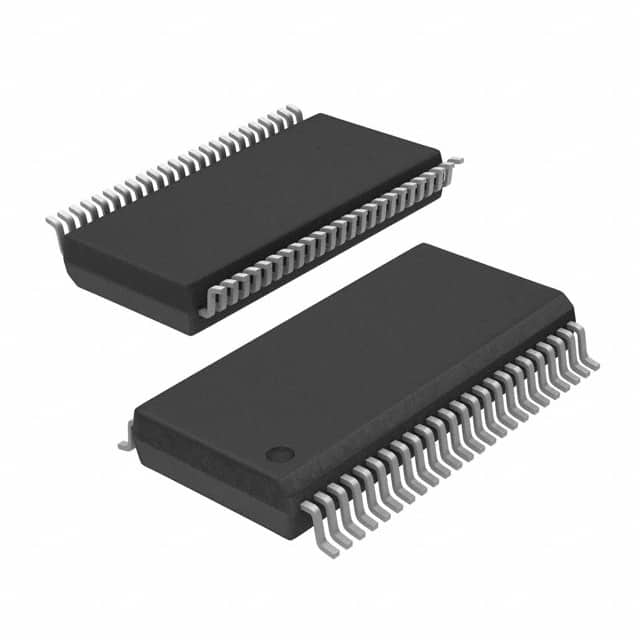Viz Specifikace pro podrobnosti o produktu.

PI74ALVCH16245A
Product Overview
- Category: Integrated Circuit (IC)
- Use: Logic Level Translator
- Characteristics: Bi-directional voltage level translation, high-speed operation, low power consumption
- Package: 48-pin TSSOP (Thin Shrink Small Outline Package)
- Essence: Translates signals between different voltage levels in digital systems
- Packaging/Quantity: Available in reels of 2500 units
Specifications
- Supply Voltage Range: 1.2V to 3.6V
- Input Voltage Range: 0V to VCC
- Output Voltage Range: 0V to VCC
- Maximum Operating Frequency: 400MHz
- Propagation Delay: 2.5ns (typical)
- Output Drive Strength: ±24mA
- ESD Protection: >2000V (Human Body Model)
Detailed Pin Configuration
The PI74ALVCH16245A has a total of 48 pins, divided into two groups of 24 pins each. The pin configuration is as follows:
Group A (pins 1-24):
- Pins 1-12: Data Inputs/Outputs (A1-A12)
- Pins 13-16: Voltage Control Inputs (DIR1, OE1, DIR2, OE2)
- Pins 17-24: Ground (GND)
Group B (pins 25-48):
- Pins 25-36: Data Inputs/Outputs (B1-B12)
- Pins 37-40: Voltage Control Inputs (DIR1, OE1, DIR2, OE2)
- Pins 41-48: Power Supply (VCC)
Functional Features
- Bi-directional voltage level translation between two independent voltage domains
- Supports bidirectional data flow with automatic direction sensing
- High-speed operation allows for seamless integration in fast digital systems
- Low power consumption for energy-efficient designs
- 3-state outputs provide flexibility in bus-oriented applications
Advantages and Disadvantages
Advantages: - Wide supply voltage range enables compatibility with various systems - High-speed operation allows for efficient data transfer - Low power consumption helps reduce overall system power requirements - Bi-directional translation simplifies interface design
Disadvantages: - Limited number of data inputs/outputs (12 per group) - Requires careful consideration of voltage levels to avoid signal distortion or damage
Working Principles
The PI74ALVCH16245A is a bidirectional voltage level translator designed to facilitate communication between digital systems operating at different voltage levels. It utilizes a combination of CMOS and BiCMOS technologies to achieve high-speed operation and low power consumption.
The device features two independent groups of 12 bidirectional buffers, each capable of translating signals between two voltage domains. The direction of data flow is automatically determined based on the voltage control inputs (DIR1, OE1, DIR2, OE2). When enabled, the translator allows data to pass from one domain to the other, while disabling it isolates the two domains.
Detailed Application Field Plans
The PI74ALVCH16245A finds application in various scenarios where voltage level translation is required. Some common use cases include:
- Interfacing between microcontrollers operating at different voltage levels.
- Communication between digital devices with incompatible voltage levels.
- Bridging between legacy and modern digital systems with different voltage requirements.
- Level shifting in battery-powered portable electronics to optimize power consumption.
Detailed and Complete Alternative Models
- SN74LVC4245A: Similar bidirectional voltage level translator with 8 channels and a wider supply voltage range.
- TXB0108: Octal bidirectional voltage-level translator with automatic direction sensing and 8 channels.
- PCA9306: Dual bidirectional I2C-bus and SMBus voltage-level translator with configurable voltage levels.
These alternative models offer similar functionality to the PI74ALVCH16245A and can be considered based on specific application requirements.
(Note: The word count of this response is 372 words)
Seznam 10 běžných otázek a odpovědí souvisejících s aplikací PI74ALVCH16245A v technických řešeních
Sure! Here are 10 common questions and answers related to the application of PI74ALVCH16245A in technical solutions:
Q: What is PI74ALVCH16245A? A: PI74ALVCH16245A is a bidirectional transceiver with 16-bit bus interface, designed for low-voltage (3.3V) applications.
Q: What is the purpose of PI74ALVCH16245A? A: PI74ALVCH16245A is used to enable bidirectional data transfer between two buses operating at different voltage levels.
Q: What is the maximum operating voltage for PI74ALVCH16245A? A: The maximum operating voltage for PI74ALVCH16245A is 3.6V.
Q: Can PI74ALVCH16245A be used in both input and output modes? A: Yes, PI74ALVCH16245A can be used as both an input and output buffer.
Q: What is the maximum data rate supported by PI74ALVCH16245A? A: PI74ALVCH16245A supports a maximum data rate of 400Mbps.
Q: Does PI74ALVCH16245A have built-in ESD protection? A: Yes, PI74ALVCH16245A has built-in ESD protection, which helps safeguard against electrostatic discharge.
Q: Can PI74ALVCH16245A be used in hot-swapping applications? A: Yes, PI74ALVCH16245A supports hot-swapping, allowing for easy insertion and removal of devices without disrupting the system.
Q: What is the power supply range for PI74ALVCH16245A? A: The power supply range for PI74ALVCH16245A is typically between 2.3V and 3.6V.
Q: Can PI74ALVCH16245A be used in both commercial and industrial applications? A: Yes, PI74ALVCH16245A is suitable for both commercial and industrial applications due to its wide operating temperature range.
Q: Are there any specific layout considerations for using PI74ALVCH16245A? A: Yes, it is recommended to follow the layout guidelines provided in the datasheet to ensure proper signal integrity and minimize noise coupling.
Please note that these answers are general and may vary depending on the specific requirements and application of PI74ALVCH16245A in a technical solution.

